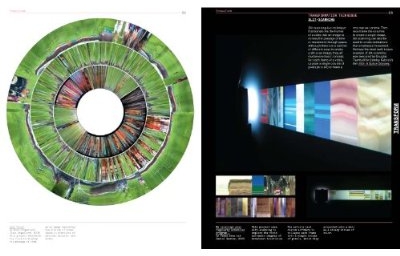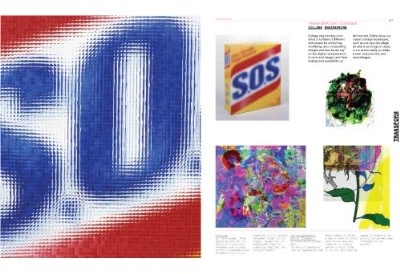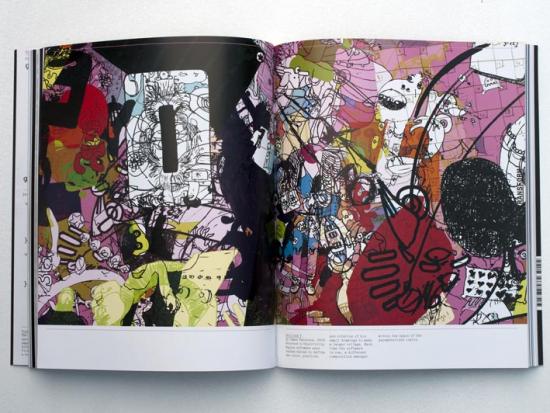



Form+Code In Design, Art and Architecture
Casey Reas, Chandler McWilliams, LUST
2010, Princeton Architectural Press
ISBN 9781568989372
Form+Code is an art computing programming primer. Rather than teaching any particular programming language it explains the technical and conceptual history of programming and its use in art. Starting with an introduction to the basic concepts of coding, instructions, form, and different ways of representing them (in sections titled “What Is Code?” and “Form And Computers”), it moves on to chapters covering “Repeat”, “Transform”, “Paramaterize”, “Visualize” and “Simulate”.
The basic concepts of programming are explained clearly with plenty of examples of code, hardware, and output. They are also related to broader art history, with examples drawn from conceptual artists such as Yoko Ono and Sol leWitt. And it’s good to see Jasia Reichardt’s pioneering work in bringing art and code together is recognised not just in the form of the Cybernetic Serendipity show at the ICA in London but her books and articles on art computing as well.
There is a little code, enough to give a flavour of what it looks like but not enough to intimidate. Listings in or examples of output from BASIC, LOGO, BEFLIX, Hypertalk and other important historical programming languages are presented. PostScript is given its due, with listings, examples of output and a discussion of its incredible impact on the graphic design industry.

Form+Code is about hardware as well as software. The Difference Engine, ENIAC, oscillioscpes, the PDP-1, arcade games machines that used vector graphics, and the Atari 2600 are all included in a historical narrative of computing and art. The book also describes and shows examples of output from printing hardware from pen plotters through laser printers to CNC and stereo lithography machines, providing a historical and conceptual grounding for thinking about the most advanced output devices currently available.
“Repeat” is explained starting with the Jacquard Loom, and the art of Bridget Riley and Andy Warhol before moving on to variations on a simple BASIC program with illustrations of its output. Packing this amount of historical, computer science and artistic information into each chapter would be overwhelming were it not for the book’s clear writing, structure and design.
“Transform” touches on Holbein’s “Ambassadors” and Victor Vasarely’s Op Art as well as the basic mathematics of folding a piece of paper. “Parameterize” has Dada, Duchamp, the Beats and Calder’s mobiles. It mentions grids without mentioning Rosalind Krauss (the book as a whole is pretty much Theory free), and explains how you use variables to produce variants on the same form.

“Visualise” and “Simulate” are almost devoid of (non-computer) art historical examples and cultural context. Harold Cohen’s AARON is illustrated, and Douglas Hofstadter, Richard Dawkins and Stephen Wolfram’s ideas are mentioned. More people should know about the wokr of Hofstadter’s FARG, and the concepts, work and writing presented are still a treasure trove of information and inspiration. But these chapters lack the art historical context of their predecessors.
The contemporary visual art computing presented is mostly in the generative art / data visualisation mold. It’s highly structured, would mostly be impossible to produce without computers, and is haunted by the possibility of being merely decorative. The only academically recognisable critical art included is one of JODI’s less threatening browser pieces. But the example of worldmapper.org in the chapter on visualisation shows how the aesthetic tools of data visualisation can be used politically. And the formal structures and creative strageties of much of the art has a quality of realism in the age of networks that is a challenge to Theory rather than a falure to illustrate it.
The success of books intended to provide a comprehensive foundation in an area of the study of art, such as “Art In Theory” or “Basic Design”, have both helped to enrich the study of art and had the unintended consequence of closing off other possible narratives. Form+Code stands to be as successful in its own area as those books were in theirs, with the same benefits and dangers. Form+Code’s ommission of virtual reality, livecoding, and other movements within art computing are understandable given its focus, but hopefully won’t lead to their neglect by students.
Could you code up any of the software art that you see in the book after reading it? No. The only code listings are historical fragments. But after reading the book you will undestand the concepts that you need both to figure out what more you need to learn in order to program such art and to understand why doing so is aesthetically and art historically worthwhile. And some source code from the book, in various programming languages, is available online.

Form+Code’s major achievement is that it presents technical, art historical and technical historical information in such a way that it complements each other and builds a bigger picture that demonstrates the wider relevance and further potential of art computing programming. Having read it, you’ll know more and you’ll both want to and be able to learn how to do more. It’s clearly laid out, packed full of illustrations, occasional code fragments, plenty of references to sources for further investigation, and even has a good index. It really is a foundation course in a book, providing a sound basis for further learning or research.
If you teach art computing, and if you are teaching art, graphic design, textiles, fashion or architecture then you are teaching art computing to a greater or lesser degree, then Form+Code is a perfect primer for the conceptual, historical, and cultural side of computing and art computing. Outside of education, if you are involved in art, computing, or are a non-programmer computer-using artist Form+Code provides a good grounding in the concepts used in programming for art computing.
Form+Code serves as a complete introduction to the conventional history, concepts and practice of visual art computing. It presents that information in the context of the broader history of art and design. And it provides enou